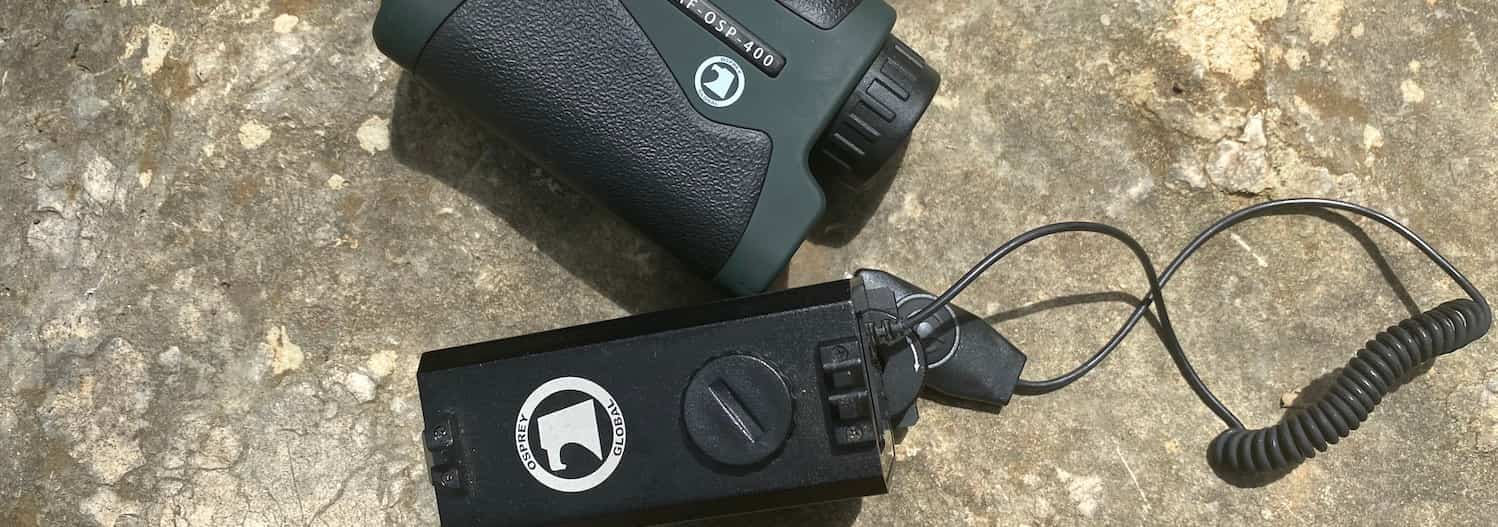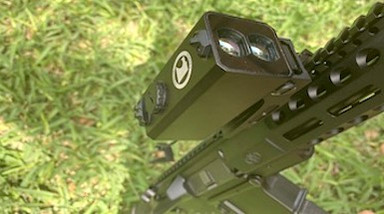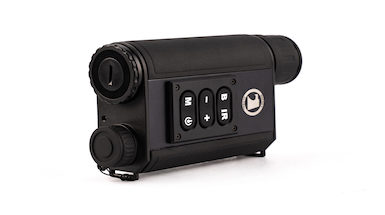Posted by Team Buy Osprey Global on May 4th 2021
Osprey Scopes Rangefinders and Reviews
Why Rangefinding Matters and What Rangefinders Will Suit You Best.
How do rangefinders work? Why is it necessary to know your distances? What's the difference between a yard and a meter? What Osprey Global Rangefinders are available, and which will suit you best? We cover all this and more today. Osprey Scopes makes more than just scopes and red dots, and their laser rangefinders are a must for any hunting enthusiast.
Why Are Osprey Rangefinders and Knowing Distance Important?
Back in the day, getting an accurate shot over 300 yards was halfway between luck and a guess. We figured out that the more variables you know the more possible the shot becomes. A lot of skills and knowledge need to be in place before you pull the trigger at plus 300 yards. You need to breathe and blink consistently and efficiently. ( Breathing Techniques For Long Range Shooting) You need to know what your gun is capable of. You need to know exactly how far your bullet will travel and how it will react to wind, weather, and gravity. You need to know your angle, MOA, and clicks. One of the most basic blocks you need to know before any of this is what distance you are shooting.
If you do not know your distance then you cannot adjust for your bullet drop. Without accurate rangefinding, all the click adjustment in the world becomes trial and error at best. The further you shoot the more pronounced even the smallest mistake becomes. An inch mistake at a hundred yards could mean you miss the target completely at a thousand.

Can't I Just Use my Eyes as Rangefinders?
No. No, you can't. that's the short answer. The long answer is a bit more complicated. If it is a place we regularly shoot we become accustomed to the distances; Between the deer blind and the tree line or the fence and the pond. This is fine to know your distances but real guessing or eyeballing of a range is difficult. There are two reasons we shouldn't rely on our estimations of distance.
Firstly; We are bad guesses. For real guesses, we find it extremely difficult. Most of our current comparisons for let's say a hundred yards is from the running track or the golf course. These are wide open and well-lit comparisons. The human brain cannot account for different lighting conditions when judging distances so when you get into a low-lit situation, it becomes almost impossible to accurately guess a distance. Add to that a tree canopy or an overcast day changing the lighting situation even more making it harder. We also judge distance using known markers like fences or poles and when we are in a wooded situation there are no markers with which to judge distance. To put it bluntly a hundred yards on a field and a hundred yards in the woods looks like two very different distances
The second reason we should avoid guessing the distance is that the more accurate your distance then the more accurate you can adjust everything else. If your distance is off then everything else will be off making it harder and harder to be accurate the further out you aim. So suppose it is 313 yards and you guess 300, then that extra 13 yards could be the difference between a kill shot and a wounded animal.
What's The Difference Between a Yard And a Meter And Why Is It Important?
We as Americans have discarded a perfectly good measuring system because we are, well, AMERICAN! The rest of the world uses kilometers, meters, and kilograms for accuracy in trade, speed, and weight. We on the other hand have decided to use the quaint roman measuring system of miles, feet, ounces, and pounds. There is no real reason for this except Americans generally want to blaze their path and are contrarians by nature.
This is no big deal except that most rangefinders will range in yards or meters not feet. Most people doing the long-range shooting will grow accustomed to using yards as their primary measurement but it's always good to know your conversions. One yard is equal to about 0.9 of a meter. One yard is three feet.
Manual Rangefinding A Known Size Target. (You Do Not Always Need A Laser Rangefinder)
Most reticles have the availability for rangefinding. Many people are blissfully unaware of how this works. The concept is easy to understand. If you have a known size target you can measure your mill dots against it. If you know the target is four feet high, and it takes three mildots to cover it then you can figure out exactly how far away it is. It gets a little bit more complicated in use. For those who just want to push a button to be told the answer skip ahead to " How Osprey Rangefinders Work" cause it's about to get very nerdy here.
In The Weeds Of Manual Rangefinding. (Nerd Alert)
To give an example of how a mil-dot reticle works for rangefinding. A MilDot reticle is named for the dots and spaces it is composed of. A Mil ( Short for milliradian) is a unit of angular measurement, like degrees or minutes of angle. It represents one unit of angular width for every 1000 units of distance. This is what allows us to range find objects of a known size without a laser rangefinder. It boils down to a deceptively simple equation.
The equation is :
object size/quantity of milsx1000= Distance
Whatever the unit you measure the object in is what unit will be used in the final distance measurement; If the object is measured in feet then you will get a measurement in feet. If it is measured in yards then your rangefinding will be in yards etc.
To do this in the field, find a known size target. measure the object with the reticle, counting how many mil sections it covers. Divide the size of the object by the number of mils then multiply that number by 1000.
It is easiest if we do it in an example:
An object has a height of 2 yards. You measure the object with the reticle and see that the object covers 5 mils.
2/5=0.4 | 0.4x1000 = 400. The object is 400 yards away
It works in meters as well
1.83/5=0.366 | 0.366x1000= 366 meters.
It does get easier the more you practice it but manual rangefinding is rare since there are so many affordable and fast rangefinders available.
Life is really simple but we insist on making it complicated- Confucius
How Do Osprey Rangefinders Work?
Yes, you push a button and it gives you the distance. That's how they OPERATE but the inner workings are also important to understand. There is a laser built into the rangefinder, when you push the button it shoots out a laser that will then bounce back to the unit. Depending on how long it takes for the laser to bounce back will tell the device how far away the object is.
An issue that can occur is early morning fog situations. The laser will hit the fog and bounce back giving an incorrect reading. This is problematic as we hunt in fog and mist all the time. In the Osprey Scopes Rangefinders, they all have a fog setting built-in. It tells the laser to go beyond the fog until it hits a substantial object meaning accurate readings no matter the weather.
Since rangefinders run off of the laser bounceback, it doesn't matter if you use them at night or day they will always be accurate. The issue at night is YOU don't know what you are looking at and therefore ranging. Osprey Global makes a Nightvision Rangefinder which solves that problem.
Which Rangefinders Are Available?
Osprey Global has three main laser rangefinders. What you are doing will dictate which one will work best for your needs. Laser Rangefinders are used mostly by hunters. Long-range target shooters usually shoot at a range where the targets are set and labeled for distance, whereas hunters could come across an elk at anywhere from 100 to 700 yards.
Osprey Global Hand-Held Rangefinder 400:
OSPREY SCOPE BEST SELLER
This is Osprey Globals Most popular Laser Rangefinder. It is also the simplest to use. It is handheld and once you put the batteries in you simply point it at the object and push the button. Don't forget the fog setting if hunting in mist.
Osprey Global Night Vision Rangefinder
Best For Hog Hunters
This unit is a must-have for hog hunters. You bring binoculars when you hunt deer, so this six-power zoom night vision rangefinder is a perfect all-in-one unit for finding varmints at night time. It gives you your angle, your distance, and lets you see in the dark. It runs on "AAA" batteries and lasts for over 2 hours. With a rangefinding range of 400 yards, it will make your next hog hunt a breeze.
Osprey Global Weapon Mounted Rangefinder
Best For AR Platforms
This unit is capable of 700 yards of rangefinding. It attaches to a Picatinny rail or can be handheld if necessary. This unit is best for people hunting with an AR Platform and doesn't want to waste time finding their handheld rangefinder in their pocket or bag, simply twist your weapon to view the rangefinder on a 45-degree mount to find your distance. It will give your distance in meters or yards, has a full fog setting, and reports the angle of distance to support long shots. Perfect for the experienced hunter.
Summary: Osprey Global Laser Rangefinders.
Osprey Global Rangefinders all come with a fog setting, can switch simply between meters and yards, and have a lifetime warranty for when you get a bit too brutal in the field.
Most people opt for the handheld version as it is the easiest and most inexpensive unit available. If you are night hunting then the night vision will be invaluable. There is no learning curve, and you will be able to accurately judge your distance up to 700 hards depending on the model you choose. A rangefinder is a valuable addition to any hunter's pack. In my book anything that lets you know where you are in proportion to something you want to shoot, kill or eat is a both a luxury AND a necessity.
"In the landscape of extinction, precision is next to godliness" - Samuell Beckett


